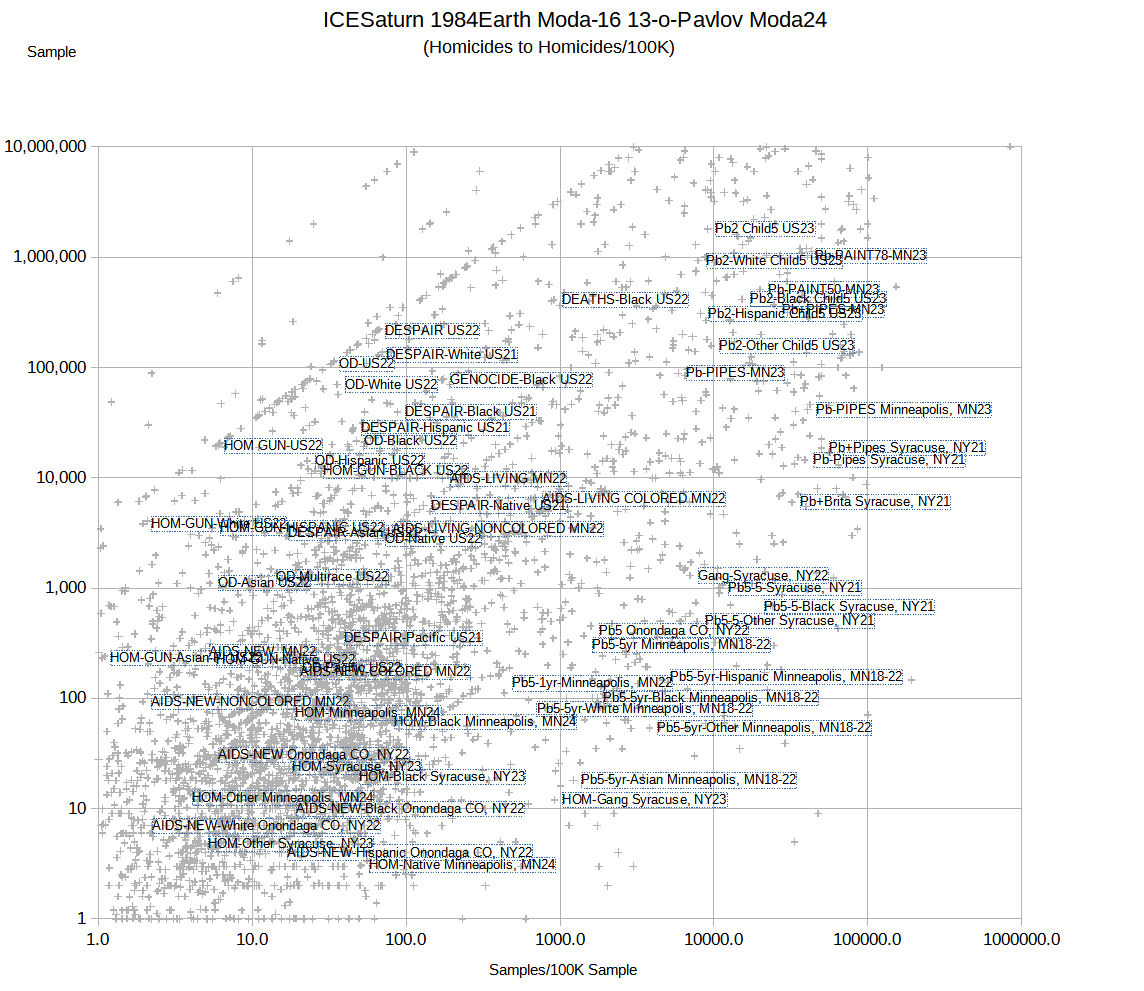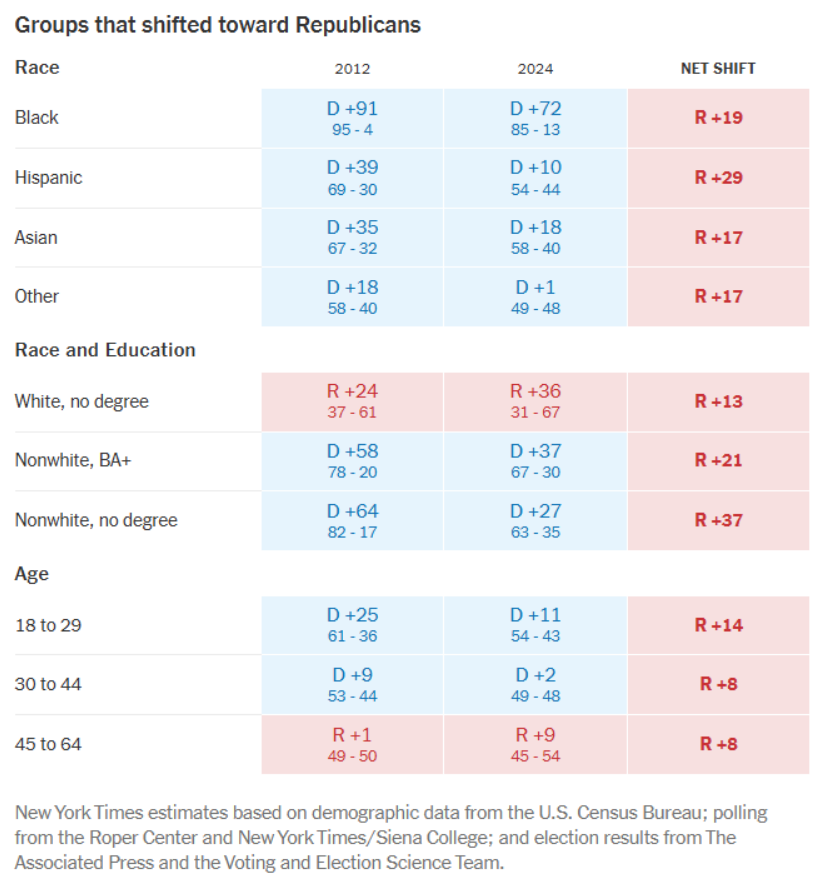


The Tilt
How Democrats Lost Their Base and Their Message
Donald Trump’s populist pitch bumped Democrats off their traditional place in American politics.
By Nate Cohn
Nov. 25, 2024
It has long been clear that the rise of Donald J. Trump meant the end of the Republican Party as we once knew it.
It has belatedly become clear that his rise may have meant the end of the Democratic Party as we knew it as well.
After three Trump elections, almost every traditional Democratic constituency has swung to the right. In fact, Mr. Trump has made larger gains among Black, Hispanic, Asian American and young voters in his three campaigns since 2016 than he has among white voters without a college degree, according to New York Times estimates. In each case, Mr. Trump fared better than any Republican in decades.
How Democrats Lost Their Base and Their Message - The New York Times
This overarching pattern requires an overarching explanation: Mr. Trump’s populist conservatism corroded the foundations of the Democratic Party’s appeal. It tapped into many of the issues and themes that once made these voters Democrats.
While the damage was mostly concealed by Mr. Trump’s unpopularity, the backlash to his norm-shattering presidency drew the Democratic Party even further from its traditional roots. The extent of that damage is now clear.
The populist message
Mr. Trump’s co-opting of these longtime Democratic themes was effective in three ways.
First, he adopted populist positions on entitlements, foreign policy, immigration, infrastructure, trade and more. On many of these issues, Mr. Trump came closer to the views of organized labor or Bernie Sanders than Mr. Romney — views that millions of working-class Democrats agreed with. Without these positions, he would have been vulnerable to the attacks that Democrats leveled against Republicans in the past.
Bernie Sanders showed there was a thirst to challenge the establishment.Credit...Kim Raff for The New York Times
Second, Democrats were deeply vulnerable to Mr. Trump’s anti-establishment critique. Over the prior two decades, Democrats took centrist and business friendly positions on key issues. Mrs. Clinton, for instance, supported NAFTA — which was enacted by her husband — and was initially a supporter of the Trans-Pacific Partnership trade deal. She supported the 2003 invasion of Iraq. These issues divided the Democratic Party during the 2016 primary; they also made it possible for Mr. Trump to argue that Democrats were the party of elites and a rigged system.
Third, Democrats were burdened by power. Even as early as 2016, disillusionment was growing. Mr. Obama enacted much of his agenda, but after eight years he wasn’t seen as having delivered full employment or “change” to business-as-usual in Washington. The rise of a new left and the strength of the Sanders campaign was one obvious expression of that disillusionment. For less progressive Democrats, the same dissatisfaction manifested in declining turnout and ultimately an openness to Mr. Trump — a path followed by some Sanders supporters as well.
In 2016, this added up to an enormous breakthrough for Mr. Trump among white voters without a college degree. The success of the Sanders campaign suggested there was opportunity for more, but Mr. Trump’s deep personal unpopularity and his penchant to offend young voters, women and Black and Hispanic voters prevented an even larger breakthrough in 2016.
The cost of anti-Trump politics
This transformation culminated during the pandemic, when Mr. Trump’s response to the coronavirus and the protests after George Floyd’s murder alarmed and outraged Democrats. The party already saw itself as the defender of civil rights and science, but Mr. Trump galvanized an even more vigilant and righteous reaction. Activists, academics and experts — often opposed to Mr. Trump — pushed a sweeping response, from school shutdowns and mask mandates to diversity statements in hiring.
For a time, none of this obviously hurt the Democrats. Joe Biden, after all, won the 2020 election. But once Mr. Trump left office and the pandemic continued, this brand of activist politics became a political liability.
As the pandemic wore on, public support for coronavirus restrictions gave way to a backlash against prolonged school closures; mask and vaccine mandates; and the public health experts who insisted on the measures. It eroded trust in government officials, elites and the media.
The social upheaval during and after the pandemic caught Democrats flat-footed. The party’s activist base had been enthralled by calls for a more compassionate immigration and criminal justice system, when suddenly the pandemic and its aftermath brought a spike in crime, rising homelessness and a new wave of border crossings. In just a year or two, liberals and progressives were seen by many as discredited.
With hindsight, this conservative reaction dealt a lasting blow to Democratic standing even before the 2024 election cycle began. Many of the most surprising swings in the election were foreshadowed in the 2022 midterms, when states like Florida and New York surged to the right. In fact, the 2024 results were more closely correlated with the 2022 midterm results for U.S. House than the 2020 presidential election. This pattern has no modern precedent, and it suggests that the backlash against Democrats during 2021 and 2022 affected the political allegiance of millions of voters — and ultimately the electoral map.
A new cast of characters in Mr. Trump’s orbit — Robert F. Kennedy Jr., Tulsi Gabbard, Elon Musk and Joe Rogan — also seemed to turn toward the right during this period. In their eyes, they didn’t change; the Democrats did.
They were hardly alone.
Graphics by Ethan Singer
Nate Cohn is The Times’s chief political analyst. He covers elections, public opinion, demographics and polling. More about Nate Cohn
https://www.nytimes.com/2024/11/25/upshot/democrats-trump-working-class.html

Comments1
First month of ICESaturn, around 600 unique visitors
First month of ICESaturn, around 600 unique visitors from 9 distinct countries, entirely by pushing Nazis awareness to Jones Day, and a few 4th Estate Nazis, while blocked and deleted by the Antitrust GNazis. Over 500 postings with over 4000 hits. So, humanity is learning.